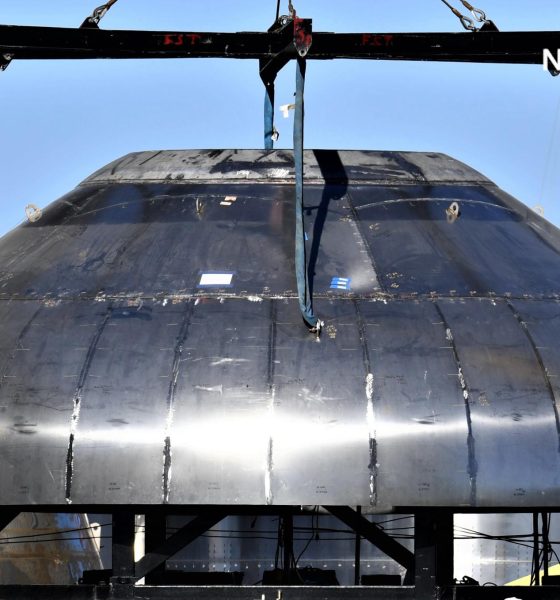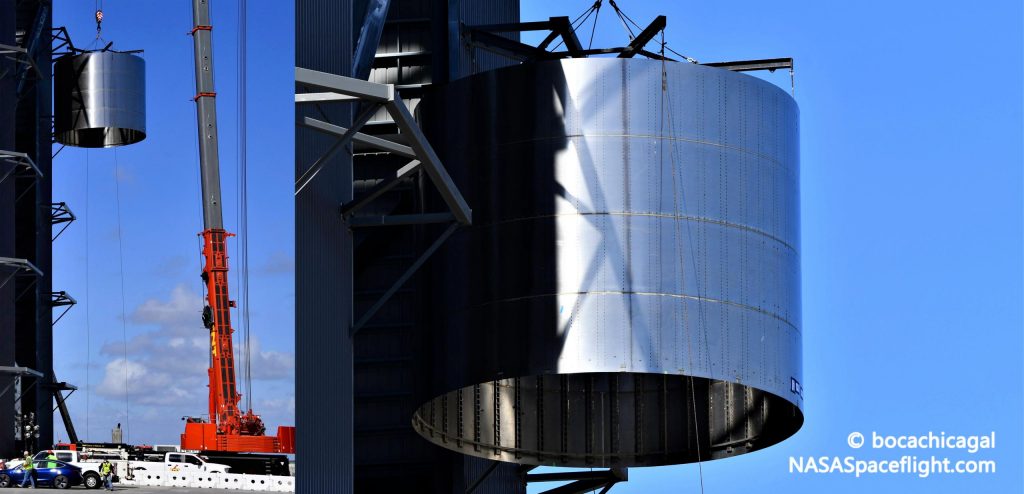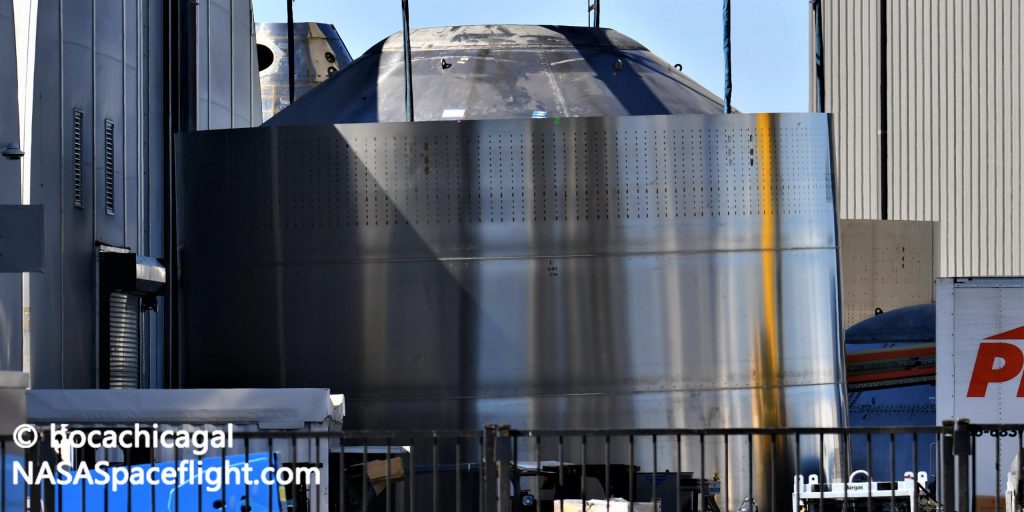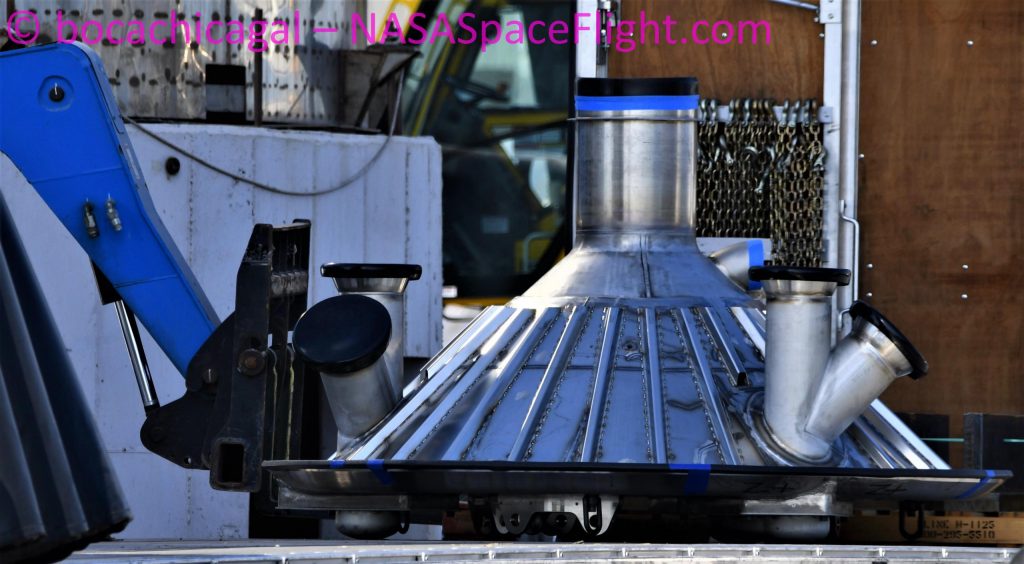

News
SpaceX’s first Starship booster a step closer as custom parts arrive
While SpaceX remains focused on Starship flight testing as the dust settles from SN8’s launch debut, the company continues to make slow but steady progress building the first Super Heavy booster prototype.
For the most part, SpaceX has learned from trial and error and developed a decent stainless steel rocket manufacturing process by building a dozen Starship prototypes over the last ~12 months, ranging from a lone nosecone tip to stout test tanks and Starship SN8, which launched to 12.5 km (~7.8 mi) earlier this month. Practically identical below the nose, Super Heavy directly benefits from that maturity and is more or less an extended Starship tank section with more engines and bigger legs.
In many ways, Super Heavy can be much simpler than Starship, as a suborbital booster has no need for header tanks, flaps, or a nosecone, and can be much stronger and heavier in all aspects. However, carrying three or more times as propellant as Starship (and carrying Starship itself), Super Heavy also needs to be stronger. All those changes – requiring new design work and new fabrication – take time. In a great sign that most of that work is complete, some of that custom hardware needed to strengthen and power Super Heavy has begun to arrive over the last several weeks.

SpaceX began stacking the first Super Heavy booster (BN1) on November 8th and appears to have more or less paused integration operations after joining eight rings. Production continued apace, however, and no less than five ring sections destined for Super Heavy appeared over the next several weeks. Why assembly slowed down is unclear but it’s reasonable to assume that SpaceX was trying to keep its focus primarily on Starship SN8’s launch debut and the preparation of several other full-scale ships, where early work on Super Heavy could ultimately be for naught if Starship flight tests uncover major design flaws.
Regardless of the reason, BN1 remains eight rings (14.5m/48ft) tall as of December 14th, representing one-fifth of Super Heavy’s full 70-meter (~230 ft) height.

On December 17th, one of the parts unique to Super Heavy unexpectedly appeared in SpaceX’s South Texas shipyard, labeled “B1 FWD PIPE DOME”. The dome was quickly sleeved with a stack of three steel rings with labels confirming that the assembly was Super Heavy BN1’s common tank dome – “common” because it’s shared by both booster propellant tanks. The new dome is unique to all previous Starship domes, featuring a smaller, more reinforced cutout – likely because Super Heavy doesn’t need header tanks.
It also appears to borrow from Starship’s forward dome design, using the same rougher steel normally used to cap off Starship methane tanks.


Unlike Starship common domes, which place a spherical methane header tank at the bottom, Super Heavy’s common dome will have a transfer tube welded directly to its nozzle-like opening. As it turns out, what could be the first Super Heavy methane transfer tube was delivered to Boca Chica late last month.
Unlike Starship transfer tubes, the new plumbing appeared to have a much wider diameter and was delivered in four sections, meshing well with the fact that Super Heavy tanks are roughly twice as tall as Starship’s. Able to support as many as 28 Raptors compared to Starship’s 6, Super Heavy transfer tubes will also need to pump more than five times as much methane per second at full thrust, which could explain the larger diameter.


Finally and perhaps most significantly, aerial photos from RGV Photography appeared to capture the first glimpse of what might be the hardest custom part required by Super Heavy – a thrust structure designed to support up to 28 Raptor engines. On December 10th, casually sitting between Starship Mk1’s remains (on the white concrete mount) and a tent, a flat ring with clear eightfold symmetry and a donut-like cutout large enough to fit a Starship thrust puck with room to spare was easily visible.
The hexagonal symmetry was the main giveaway, matching comments from CEO Elon Musk that Super Heavy’s thrust structure will feature a central ring of eight engines surrounded by an outer ring of up to 20 more Raptors. Assuming the first Super Heavy booster only flies with a few Raptor engines, that sole eight-engine ‘puck’ may be all that SpaceX needs to complete BN1.


News
Tesla aims to combat common Full Self-Driving problem with new patent
Tesla writes in the patent that its autonomous and semi-autonomous vehicles are heavily reliant on camera systems to navigate and interact with their environment.

Tesla is aiming to combat a common Full Self-Driving problem with a new patent.
One issue with Tesla’s vision-based approach is that sunlight glare can become a troublesome element of everyday travel. Full Self-Driving is certainly an amazing technology, but there are still things Tesla is aiming to figure out with its development.
Unfortunately, it is extremely difficult to get around this issue, and even humans need ways to combat it when they’re driving, as we commonly use sunglasses or sun visors to give us better visibility.
Cameras obviously do not have these ways to fight sunglare, but a new patent Tesla recently had published aims to fight this through a “glare shield.”
Tesla writes in the patent that its autonomous and semi-autonomous vehicles are heavily reliant on camera systems to navigate and interact with their environment.

The ability to see surroundings is crucial for accurate performance, and glare is one element of interference that has yet to be confronted.
Tesla described the patent, which will utilize “a textured surface composed of an array of micro-cones, or cone-shaped formations, which serve to scatter incident light in various directions, thereby reducing glare and improving camera vision.”

The patent was first spotted by Not a Tesla App.
The design of the micro-cones is the first element of the puzzle to fight the excess glare. The patent says they are “optimized in size, angle, and orientation to minimize Total Hemispherical Reflectance (THR) and reflection penalty, enhancing the camera’s ability to accurately interpret visual data.”
Additionally, there is an electromechanical system for dynamic orientation adjustment, which will allow the micro-cones to move based on the angle of external light sources.
This is not the only thing Tesla is mulling to resolve issues with sunlight glare, as it has also worked on two other ways to combat the problem. One thing the company has discussed is a direct photon count.
CEO Elon Musk said during the Q2 Earnings Call:
“We use an approach which is direct photon count. When you see a processed image, so the image that goes from the sort of photon counter — the silicon photon counter — that then goes through a digital signal processor or image signal processor, that’s normally what happens. And then the image that you see looks all washed out, because if you point the camera at the sun, the post-processing of the photon counting washes things out.”
Future Hardware iterations, like Hardware 5 and Hardware 6, could also integrate better solutions for the sunglare issue, such as neutral density filters or heated lenses, aiming to solve glare more effectively.
Elon Musk
Delaware Supreme Court reinstates Elon Musk’s 2018 Tesla CEO pay package
The unanimous decision criticized the prior total rescission as “improper and inequitable,” arguing that it left Musk uncompensated for six years of transformative leadership at Tesla.

The Delaware Supreme Court has overturned a lower court ruling, reinstating Elon Musk’s 2018 compensation package originally valued at $56 billion but now worth approximately $139 billion due to Tesla’s soaring stock price.
The unanimous decision criticized the prior total rescission as “improper and inequitable,” arguing that it left Musk uncompensated for six years of transformative leadership at Tesla. Musk quickly celebrated the outcome on X, stating that he felt “vindicated.” He also shared his gratitude to TSLA shareholders.
Delaware Supreme Court makes a decision
In a 49-page ruling Friday, the Delaware Supreme Court reversed Chancellor Kathaleen McCormick’s 2024 decision that voided the 2018 package over alleged board conflicts and inadequate shareholder disclosures. The high court acknowledged varying views on liability but agreed rescission was excessive, stating it “leaves Musk uncompensated for his time and efforts over a period of six years.”
The 2018 plan granted Musk options on about 304 million shares upon hitting aggressive milestones, all of which were achieved ahead of time. Shareholders overwhelmingly approved it initially in 2018 and ratified it once again in 2024 after the Delaware lower court struck it down. The case against Musk’s 2018 pay package was filed by plaintiff Richard Tornetta, who held just nine shares when the compensation plan was approved.
A hard-fought victory
As noted in a Reuters report, Tesla’s win avoids a potential $26 billion earnings hit from replacing the award at current prices. Tesla, now Texas-incorporated, had hedged with interim plans, including a November 2025 shareholder-approved package potentially worth $878 billion tied to Robotaxi and Optimus goals and other extremely aggressive operational milestones.
The saga surrounding Elon Musk’s 2018 pay package ultimately damaged Delaware’s corporate appeal, prompting a number of high-profile firms, such as Dropbox, Roblox, Trade Desk, and Coinbase, to follow Tesla’s exodus out of the state. What added more fuel to the issue was the fact that Tornetta’s legal team, following the lower court’s 2024 decision, demanded a fee request of more than $5.1 billion worth of TSLA stock, which was equal to an hourly rate of over $200,000.
Delaware Supreme Court Elon Musk 2018 Pay Package by Simon Alvarez
News
Tesla Cybercab tests are going on overdrive with production-ready units
Tesla is ramping its real-world tests of the Cybercab, with multiple sightings of the vehicle being reported across social media this week.

Tesla is ramping its real-world tests of the Cybercab, with multiple sightings of the autonomous two-seater being reported across social media this week. Based on videos of the vehicle that have been shared online, it appears that Cybercab tests are underway across multiple states.
Recent Cybercab sightings
Reports of Cybercab tests have ramped this week, with a vehicle that looked like a production-ready prototype being spotted at Apple’s Visitor Center in California. The vehicle in this sighting was interesting as it was equipped with a steering wheel. The vehicle also featured some changes to the design of its brake lights.
The Cybercab was also filmed testing at the Fremont factory’s test track, which also seemed to involve a vehicle that looked production-ready. This also seemed to be the case for a Cybercab that was spotted in Austin, Texas, which happened to be undergoing real-world tests. Overall, these sightings suggest that Cybercab testing is fully underway, and the vehicle is really moving towards production.
Production design all but finalized?
Recently, a near-production-ready Cybercab was showcased at Tesla’s Santana Row showroom in San Jose. The vehicle was equipped with frameless windows, dual windshield wipers, powered butterfly door struts, an extended front splitter, an updated lightbar, new wheel covers, and a license plate bracket. Interior updates include redesigned dash/door panels, refined seats with center cupholders, updated carpet, and what appeared to be improved legroom.
There seems to be a pretty good chance that the Cybercab’s design has been all but finalized, at least considering Elon Musk’s comments at the 2025 Annual Shareholder Meeting. During the event, Musk confirmed that the vehicle will enter production around April 2026, and its production targets will be quite ambitious.








